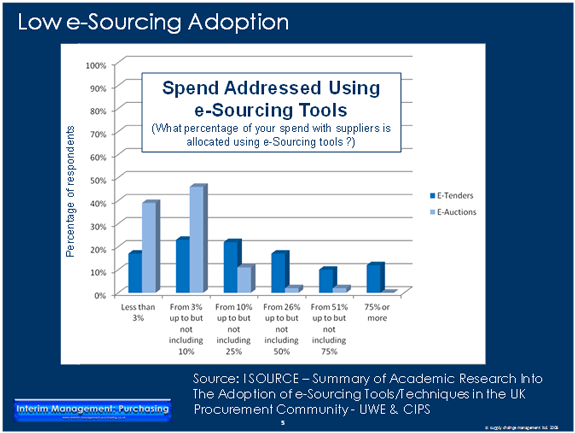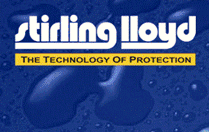
|

Successfully Implementing e-Sourcing
The e-Sourcing Adoption Problem
There are plenty of success stories for e-Sourcing programmes. Having understood the benefits,, many companies have tried to introduce their own e-Sourcing platform. However, as with most software suites, it's not just a case of buying access to a platform and three months later "bingo" you've delivered a step-change in performance. In fact research shows quite the opposite.


AT Kearney say:
"...while more than 75% of companies report that their procurement organisations have used these tools at least once, only a small fraction report using them in any significant way (defined as more than 200 on line RFXs or reverse auctions per year)". Source: JumpStarting Your e-Sourcing Initiative
A similarly disappointing story is told by CIPS and the University of the West of England (UWE)'s study on e-Sourcing adoption in the UK.
Clearly then, there are substantial challenges getting e-Sourcing platforms successfully adopted.
Other companies seem to have no problems whatsoever getting remarkably high levels of adoption. Take Maersk for example, as published in conjunction with CombineNet.

Why is the Adoption Generally So Low in Reality ?
Often two perspectives about e-Sourcing are expressed.
- Category Managers who are non-users, typically take the view that e-Sourcing can be a valuable tool, when applied under the right circumstances, but it's just not appropriate i). for my category and/or ii). my suppliers and/or iii). at this time. This view is often naively expressed when Category Managers associate e-Sourcing almost entirely with e-Auctions, which are viewed as significant emotional events for both suppliers and buyers. However...
- For Category Managers who are prepared to embrace the approach, e-Sourcing becomes a "way of life". Just because particular categories don't lend themselves to e-Auctions, doesn't mean they don't benefit. On the contrary the benefits from e-Sourcing aside from reverse auctions are still remarkable.
Making e-Sourcing a "Way of Life"
The good news is that there are several ways though that CPOs can encourage the adoption of e-Sourcing to enable it to become a new "way of life" for the team.
1. Set-up a Centre of Excellence
Those organisations which have developed high levels of e-Sourcing adoption most often have dedicated specialists supporting the process. Not only are they platform super-users, but they act as a focal point for the intersection of e-Sourcing process and category knowledge, ensure the smooth running of events, minimising buyer, supplier and stakeholder anxieties and ensure best practises are shared. Their presence can ensure that risks are managed well enough to enable key stakeholders to be invited to observe auctions in real time - a source of invaluable PR. Typically they build and develop all of the necessary process documentation and communication materials including case studies - all of which helps to build confidence. They track e-Sourcing programme performance metrics and will identify areas of spend with untapped potential. Central e-Sourcing teams can also support some of the more mundane configuration work and do the leg-work of coaching and encouraging suppliers that are new to the process to join in and complete e-RFXs on time. As more modules are introduced, such as, Spend Analysis, Contract Lifecycle Management (CLM), Supplier Relationship Management (SRM), such teams role expands necessarily. Increasingly some of this support is being moved to near-shore or off-shore locations to keep costs down.
2. Build in e-RFIs, e-RFQs & Auctions into Your Standard Sourcing Process
Professional purchasing teams drive a consistent approach by using standardised sourcing processes, with process maps, templates and guidelines. Within these processes e-Sourcing tools such as e-RFIs, e-RFQs and e-Auctions should be identified as specific process steps. Consequently when the progress of sourcing projects are reviewed at phase gate reviews, the use of e-Sourcing tools can be repeatedly encouraged by procurement leaders.
3. Set Annual Objectives for Category Managers to Configure e-RFIs & e-RFXs First.
Even companies who claim to do more than 1000 e-Auctions per annum (e.g. Maersk since 2010) wish to have more e-Sourcing events led by their category management teams, rather than be so reliant on the facilitation of the central e-Sourcing support team. Some of the explanations which hold this next generation of adoption by Category Managers up, typically include; "lack of time", fear of the unknown, unwillingness to learn the nuts and bolts of a new software platform, a preference for face to face negotiations, and for those that associate e-Sourcing almost entirely with e-Auctions, a fear of an auction being a significant emotional event and potential risk to supplier relationships. Category Managers fear that suppliers won't engage completely during auctions and that they'll loose face. So, break the scary process down into steps which aren't significant emotional events for anyone and build these into Category Managers' annual objectives. Start with encouraging a certain number of e-RFIs and e-RFQs/e-RFPs. However, defer setting objectives for Category Managers to configure auctions until they've successfully configured several e-RFXs first. Approaching it this way demystifies the process and builds confidence amongst both buyers and suppliers before stakes are raised.
This sort of measured approach benefits suppliers and internal stakeholders too. It allows them to gently get used to the platform; specifically, logging in, rules of engagement, the process of accepting any pre-requisites, inputing information. It's by no means a scary process. Then move on to encouraging e-RFQs (or e-RFPs). Having participated in an e-RFI, from the perspective of the supplier this demands little more than the submission of pricing through the platform, rather than in al spreadsheet. Again, not a scary process.
4. Structure Your Communication with Suppliers
Have a formal process for communicating with suppliers in respect of your e-Sourcing programme. Generally speaking, down-play the role of auctions and try to avoid using the A word entirely if you can, to suppliers who aren't yet familiar with the technology during the roll-out. Provide a standard introductory e-Sourcing slide deck and/or internet page which emphasises that the benefits of the approach in a balanced way including:
- developing a repeatable process,
- reducing the cycle time of the sourcing process,
- improving knowledge management,
- reducing the time spent on administration,
- providing traceability throughout the entire e-Sourcing process,
- ensuring that suppliers quote in a like for like manner,
- etc.
Acknowledge that some will want to circumvent e-Sourcing events, so condition all suppliers up-front by making it clear that company policy is that only submissions through the platform will be considered and that bidders not submitting through the platform will not receive feedback about the relative competitiveness of their pricing.
Provide details of the platform help-desk so suppliers know who to speak to when they have questions. Provide links to on-line help and manuals and if necessary develop simple training documents to guide suppliers through any parts of the process which aren't as intuitive as they should be.
Clearly document "Rules of Engagement" for each event.
It's a fallacy to think that you can rely on daily reminder emails being sent out by the platform about the event closing date to get reticent suppliers to participate. e-Sourcing isn't a "hands off" process. Acknowledge that suppliers who are new to the process are probably dealing with the "fear of the unknown", and would prefer to do things the way they always have. So call them. Talk to suppliers and encourage their participation whilst the e-Sourcing event is live. If necessary, give them a helping hand. Guide them through the process either personally or through the central e-Sourcing team, to reassure them. In return they'll tell you if something is presented in a confusing way, so that you can make relevant changes for the benefits of all of the suppliers.
And once the event is over, give the participants feedback. Make them feel that the effort they expended was worthwhile and encourage their contribution for the next time.
5. Measure the e-Sourcing Programme & Drive Continuous Improvement
- Total and percentage savings delivered through the e-Sourcing process (overall and by category)
- Number of e-RFIs
- Number of e-RFQ/Ps or Auctions (overall and by category)
- Value of spend subjected to e-RFQ/Ps or Auctions (overall and by category)
- Proportion of all Spend Subject to e-RFQ/P or Auction (overall and by category).
- e-Sourcing process cycle time (overall and by category).
The following are courtesy of Ariba Exchange
User Related
- No. of Active Suppliers
- No. of registered Supplier
- No. of registered Buyers
- No. of trained users
- No. active users
Project Related
- No. of new projects per month
- No. of projects (cumulative)
- No. of Sourcing Projects per month
- No. of events per month per Type
Spend Related
- No. of Categories Sourced
- Spend volume processed per month
- Spend volume cumulative
Process Related
- No. of Sourcing Process Templates
- No. of custom RFx Templates
- No. of category specific items (cost breakdown templates)
Not Exhaustive
These five points aren't exhaustive of course. And they're not the only persepctive on the subject either. Below are ten steps to e-Sourcing success as proposed by AT Kearney and GlaxoSmithKline. Another ten points are proposed by the Aberdeen Group.
AT Kearney and GlaxoSmithKline's Ten Points for e-Sourcing Success
Greg Brandyberry knows a thing or two about running successful e-Sourcing programmes. As the former VP Procurement of Global Systems and Operations GlaxoSmithKline (GSK) was awarded the prestigious Chartered Institute of Purchasing and Supply CIPS award for “Best Use of Technology by a Procurement Organization”. Subsequently AT Kearney identified GSK as having deployed a global best-practice portfolio of electronic procurement tools in their 2005 Assessment for Excellence in Procurement. In 2010 he co-authored the AT Kearney paper "JumpStarting Your e-Sourcing Initiative" which shares the following ten key learnings:
- Get the right technology
- Identify & prepare a core group of technology savvy employees
- Develop an initial pipeline of e-Sourcing events for categories with robust specifications and suppliers willing to compete.
- Establish a virtual centre of excellence with a dedicated technology centre
- Invite key stakeholders and business clients to watch e-Sourcing events
- Publicise the successes and give credit to participating business partners
- Obtain visible support from senior executives
- Develop and execute a change management strategy that wins over the sceptics
- Set ambitious programme goals
- Run a fair ethical and transparent programme, no matter what
Aberdeen Group's Ten Recommendations for e-Sourcing Success
The independent analysts Aberdeen Group have researched the subject of e-Sourcing and recommend their own ten points for e-Sourcing success.
- Adopt and validate best-in-class strategic sourcing procedures before investing in e-Sourcing technologies.
- Ensure proper executive and stakeholder support for sourcing and dedicate a manager to champion the program.
- Develop systems and competencies to make total spending analysis an efficient and repeatable process.
- Examine market dynamics, scrutinize supplier capabilities, and define sourcing tools and strategies prior to negotiation.
- Clearly define requirements & expectations to both internal stakeholders and suppliers.
- Tap external parties for category expertise and sourcing methods & process support.
- Define protocols for assessing proper negotiation tools and techniques for each spend category or sourcing scenario.
- Establish channel to communicate e-Sourcing strategies and results to stakeholders.
- Align processes, systems, and incentives to ensure compliance.
- Adopt procedures and systems to measure internal and external supply performance.
Source:
Aberdeen Group
More Information
Go back to the start of Interim Management Purchasing ?
© www .interim-management-purchasing.co.uk June 2012 |


A global leader in the polymer engineering protection of civil engineering structures.
“David was appointed in the role of Interim Group Procurement Director"
"Using the Ariba e-Sourcing platform, David was then able to demonstrate the effectiveness of this practise with a 22% saving in this chemical category"
"I wouldn't hesitate to recommend David's services to any company".
Full SL plc reference  |

